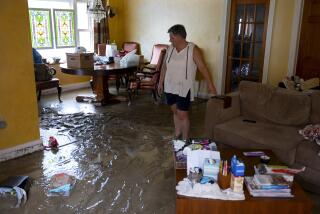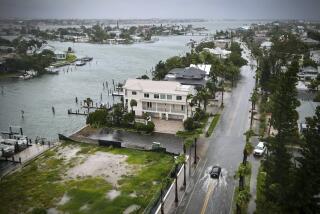Hurricane Sandy, rare ‘super storm,’ prompts East Coast preparation
As the Eastern Seaboard braces for the impact of Hurricane Sandy, governors in at least six states, including New Jersey, New York and Connecticut, have declared states of emergency ahead of what is forecast to be a rare and damaging “super storm” that could affect a third of the nation.
From New York to the Carolinas, state officials are urging residents and businesses to prepare for the worst -- drenching rain, flooding, high winds, highs seas, snow, widespread power outages. Federal officials stressed that the impact will extend into the Ohio Valley.
There is also a potential for river flooding in Pennsylvania, Virginia and Maryland, federal officials said Saturday.
In New York, state officials Saturday warned residents that public transit could shut down by 7 p.m. Sunday and be closed all day Monday. They will make a decision Sunday based on the latest forecasts.
The storm was moving north in the Atlantic on Saturday and is expected to barrel into the mid-Atlantic states or Northeast early Tuesday morning.
The storm is expected to merge with a cold front swooping across the Ohio Valley from Canada, which is forecast to create snowstorms and up to eight inches of rain. To make matters worse, there will be a full moon Sunday, which bring higher tides in the days after its initial appearance.
Winds could reach 60 mph in some places, slightly less over vast stretches of the region when it hits land. New York will shut down its bridges in the event of 60 mph winds, state officials said at a news conference Saturday.
Hurricane Sandy killed dozens this week as it blasted through the Caribbean and is projected to be downgraded to a tropical storm by next week.
New Jersey Gov. Chris Christie ordered evacuations of the state’s barrier islands and its Atlantic City casinos by Sunday afternoon. Both President Obama and Republican candidate Mitt Romney have canceled events on the East Coast ahead of the storm’s arrival.
The Federal Emergency Management Agency has dispatched workers to the mid-Atlantic and into New England. State officials across the region have told the public to prepare for limited travel and airport closures. Residents on the East Coast were stocking up on water and food Saturday.
Several states have reached out to their inland neighbors for utility crews, asking them to be on alert in case there are massive, prolonged power outages.
The Navy, after initially telling its fleet to head out into the Atlantic to avoid the storm, decided that those already in port should stay there, the Virginian-Pilot reported Saturday.
Meteorologists from the National Weather Service said Sandy could easily cause more than $1 billion in damage. Her winds will not be hurricane strength, but Sandy’s reach will be great.
Saturday, winds up to 75 mph were measured up to 100 miles away from the eye of the storm.
Forecasters said the cost of cleaning up after Sandy could eclipse 2011’s Hurricane Irene, which cost an estimated $15 billion, according to the Associated Press.
New York officials said they could see a 4- to 8-foot storm surge and are covering subway entrances with sandbags and wooden planks in preparation.
The storm will idle somewhere between the mid-Atlantic and New England because of an unusual atmospheric condition called “blocking,” meaning a series of high-pressure systems pockmarking the United States will essentially block the storm in place, forcing it to spin like a top over one area before it eventually loses energy.
ALSO:
Planned Parenthood battles Texas in court over funding
ACLU sues Homeland Security over photos, video restrictions
Texas trooper in chopper shoots, kills 2 suspected illegal immigrants
More to Read
Sign up for Essential California
The most important California stories and recommendations in your inbox every morning.
You may occasionally receive promotional content from the Los Angeles Times.











